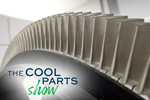Video: Additive Manufacturing for Aircraft Blade Repair
Optomec machines use directed energy deposition guided by optical measurement and automatic programming to repair aircraft engine blades. Here is a look at the 3D printing repair operation.
Share
Read Next
One important application of metal additive manufacturing in the aerospace industry involves not making new parts, but repairing existing ones. Aircraft engine blades such as compressor and turbine blades are subject to wear. Historically these components have been repaired manually, through the work of a skilled welder, but 3D printing via directed energy deposition (DED), guided by optical measurement of the worn blade for generating custom program paths, offers the chance for an automated, unattended system to perform this repair operation. During a visit to Optomec’s facility in Clover, South Carolina, I saw how additive manufacturing for aircraft engine blade repair works. This video shows DED of Inconel 625 applied in two different types of paths to repair the tips of a compressor blade and a turbine blade.
How DED Plus Robotic Finishing Achieves Fully Automated Blade Repair Process
A system developed by Optomec in collaboration with Acme Manufacturing combines additive manufacturing via directed energy deposition with precise abrasive machining via robot to repair up to 85,000 aircraft engine blades per year. READ
Related Content
-
At General Atomics, Do Unmanned Aerial Systems Reveal the Future of Aircraft Manufacturing?
The maker of the Predator and SkyGuardian remote aircraft can implement additive manufacturing more rapidly and widely than the makers of other types of planes. The role of 3D printing in current and future UAS components hints at how far AM can go to save cost and time in aircraft production and design.
-
6 Reasons Space Exploration Will Need Additive Manufacturing
There are at least half a dozen ways 3D printing will contribute to space travel, research and habitation — and in some cases it already is. Insights from seminar focused on manufacturing challenges for the space sector.
-
Additive Manufacturing Is Subtractive, Too: How CNC Machining Integrates With AM (Includes Video)
For Keselowski Advanced Manufacturing, succeeding with laser powder bed fusion as a production process means developing a machine shop that is responsive to, and moves at the pacing of, metal 3D printing.













